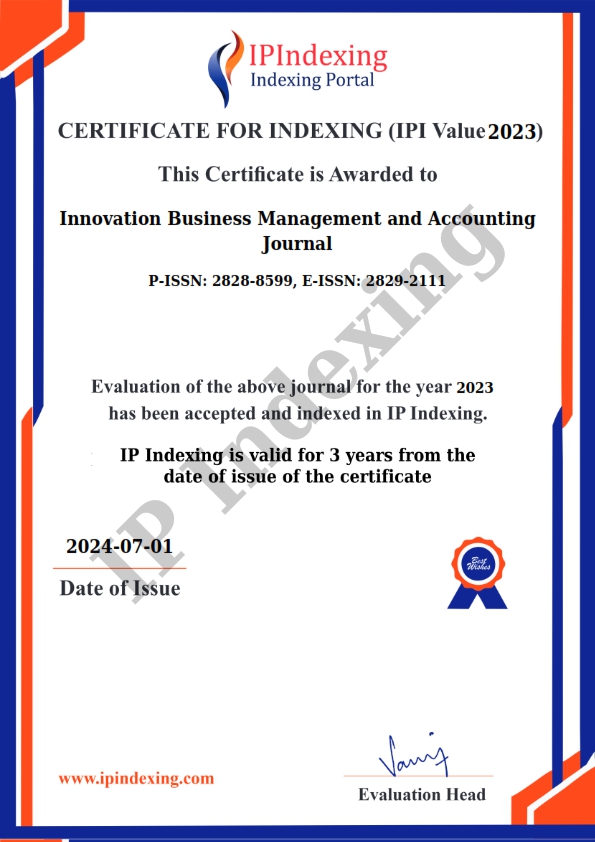Empirical Analysis of Tax Avoidance in Main Board Property and Real Estate Companies on IDX (2022-2024)
DOI:
https://doi.org/10.56070/ibmaj.2025.029Keywords:
Audit Quality, Capital Intensity, Debt Policy, Financial Performance, Tax AvoidanceAbstract
This study aims to examine the effect of audit quality, debt policy, capital intensity, and financial performance on tax avoidance in property and real estate sector companies listed on the Indonesia Stock Exchange during the period 2022-2024. Using multiple regression analysis of 39 observations, the results showed that only financial performance has a negative and significant effect on tax avoidance. Other variables, namely audit quality, debt policy, and capital intensity, have no significant effect. This finding supports the view that companies with high profitability tend to be more compliant with fiscal obligations in order to maintain their reputation and credibility in the eyes of stakeholders. Conversely, companies with low profitability are more prone to aggressive tax planning practices. This study provides empirical evidence that profitability is an important factor in controlling the level of tax avoidance, and emphasizes the importance of more intensive supervision of companies with weak financial performance. Policy implications suggest the need for a risk-based approach in tax supervision and reformulation of the effectiveness of the role of external auditors in detecting fiscal non-compliance.
Downloads
References
Arnidhya Nur Zhafira. (2024). BKPM: Sektor properti sumbang Rp122,9 triliun realisasi investasi 2024 - ANTARA News. https://www.antaranews.com/berita/4777085/bkpm-sektor-properti-sumbang-rp1229-triliun-realisasi-investasi-2024
Assidi, S., Aliani, K., & Omri, M. A. (2016). Tax optimization and the firm’s value: Evidence from the Tunisian context. Borsa Istanbul Review, 16(3), 177–184. https://doi.org/10.1016/j.bir.2016.04.002
Atmamiki, K. T., & Priantinah, D. (2023). Pengaruh Leverage, Cash Holding, Ukuran Perusahaan, dan Kualitas Audit terhadap Manajemen Laba dengan Kepemilikan Manajerial sebagai Variabel Moderasi. Nominal Barometer Riset Akuntansi Dan Manajemen, 12(2), 227–241. https://doi.org/10.21831/nominal.v12i2.59214
Deangelo, L. E. (1981). Auditor Size And Audit Quality. In Journal of Accounting and Economics (Vol. 3). North-Holland Publishing Company.
Derashid, C., & Zhang, H. (2003). Effective tax rates and the “industrial policy” hypothesis: evidence from Malaysia. Journal of International Accounting, Auditing and Taxation, 12(1), 45–62. https://doi.org/10.1016/S1061-9518(03)00003-X
Dyreng, S. D., Hanlon, M., & Maydew, E. L. (2008). Long-Run Corporate Tax Avoidance. In THE ACCOUNTING REVIEW (Vol. 83, Issue 1).
El Badlaoui, A., Cherqaoui, M., & Taouab, O. (2021). Output indicators of audit quality: A framework based on literature review. In Universal Journal of Accounting and Finance (Vol. 9, Issue 6, pp. 1405–1421). Horizon Research Publishing. https://doi.org/10.13189/ujaf.2021.090619
Fernández-Rodríguez, E., García-Fernández, R., & Martínez-Arias, A. (2021). Business and institutional determinants of Effective Tax Rate in emerging economies. Economic Modelling, 94, 692–702. https://doi.org/10.1016/j.econmod.2020.02.011
Garcia-Bernardo, J., & Janský, P. (2024). Profit shifting of multinational corporations worldwide. World Development, 177, 106527. https://doi.org/10.1016/j.worlddev.2023.106527
Gayatri, A. A. A. N., & Damayanthi, I. G. A. E. (2024). Ukuran Perusahaan, Intensitas Modal, Financial Distress, dan Penghindaran Pajak. E-Jurnal Akuntansi, 34(2). https://doi.org/10.24843/EJA.2024.v34.i02.p17
Hadi, F. I., & Tifani, S. (2020). Pengaruh Kualitas Audit dan Auditor Switching Terhadap Manajemen Laba. Jurnal Ilmiah Akuntansi Dan Keuangan, 9(2), 117–129. https://doi.org/10.32639/jiak.v9i2.408
Hanlon, M., & Heitzman, S. (2010). A review of tax research. Journal of Accounting and Economics, 50(2–3), 127–178. https://doi.org/10.1016/j.jacceco.2010.09.002
Jensen, M. C., & Meckling, W. H. (1976). Theory of the firm: Managerial behavior, agency costs and ownership structure. Journal of Financial Economics, 3(4), 305–360. https://doi.org/10.1016/0304-405X(76)90026-X
Kalbuana, N., Suryati, A., Puspa, C., & Pertiwi, A. (2022). Effect Of Company Age, Audit Quality, Leverage And Profitability On Earnings Management. Business and Accounting Research (IJEBAR) Peer Reviewed-International Journal, 6. https://jurnal.stie-aas.ac.id/index.php/IJEBAR
Khairunnisa, N. R., Simbolon, A. Y., & Eprianto, I. (2023). Pengaruh Leverage, Profitabilitas, Good Governance Terhadap Penghindaran Pajak (Tax Avoidance). Jurnal Economina, 2(8), 2164–2177. https://doi.org/10.55681/economina.v2i8.726
Kraus, A., & Litzenberger, R. H. (1973). A State‐Preference Model Of Optimal Financial Leverage. The Journal of Finance, 28(4), 911–922. https://doi.org/10.1111/j.1540-6261.1973.tb01415.x
Li-Ju Chen Shun-Yu Chen, A. (2021). “The influence of profitability on firm value with capital structure as the mediator and firm size and industry as moderators.”
Nurhasanah, S., & Indradi, D. (2024). Pengaruh Intensitas Modal, Pertumbuhan Penjualan, Dan Financial Distress Terhadap Penghindaran Pajak (Studi Empiris Perusahaan Property Dan Real Estate Yang Terdaftar Di Bei Tahun 2018-2022). Indonesia Journal of Management Studies. https://dmi-journals.org/ijms/index
Panda, A. K., & Nanda, S. (2020). Receptiveness of effective tax rate to firm characteristics: an empirical analysis on Indian listed firms. Journal of Asia Business Studies, 15(1), 198–214. https://doi.org/10.1108/JABS-11-2018-0304
Richardson, G., Taylor, G., & Lanis, R. (2015). The impact of financial distress on corporate tax avoidance spanning the global financial crisis: Evidence from Australia. Economic Modelling, 44, 44–53. https://doi.org/10.1016/j.econmod.2014.09.015
Sembiring, Y. C. B., & Hutabalian, Y. N. (2022). Pengaruh Profitabilitas, Likuiditas Dan Leverage Terhadap Penghindaran Pajak Pada Perusahaanproperty Dan Real Estate Yang Terdaftar Di Bei Tahun 2015-2019. JRAK, 8. https://doi.org/https://doi.org/10.54367/jrak.v8i1.1753
Sumantri, I. R. I. R., & Kurniawati, L. (2023). Pengaruh Profitabilitas, Likuiditas, Leverage, Dan Capital Intensity Terhadap Penghindaran Pajak Perusahaan Properti Dan Real Estate Yang Terdaftar Di BEI Periode 2019-2021. In Management Studies and Entrepreneurship Journal (Vol. 4, Issue 2). http://journal.yrpipku.com/index.php/msej
Thayyib, P. V. (2025). Firm-specific determinants influencing tax avoidance among Indian multinational corporations: a panel regression approach. Cogent Economics and Finance, 13(1). https://doi.org/10.1080/23322039.2025.2483869
Watts, R. L., & Zimmerman, J. L. (1990). Positive Accounting Theory: A Ten Year Perspective. The Accounting Review.
Widiantono, R. R., & Marinda, N. (2024). Intensitas Modal, Tata Kelola Perusahaan & Profitabilitas Terhadap Penghindaran Pajak (Vol. 2, Issue 2). www.kompasiana.com
Wulandari, T., Safitri, A. D., Hadijah, C., & Sanjaya, R. (2024). Pengaruh Pertumbuhan Penjualan, Intensitas Modal, Profitabilitas Dan Kepemilikan Institusional Terhadap Penghindaran Pajak (Pada Perusahaan Properti, Real Estate Dan Kontruksi Yang Terdaftar Di Bursa Efek Indonesia Tahun 2019 - 2023). TEKNOBIS.
Downloads
Published
How to Cite
Issue
Section
License
Copyright (c) 2025 Jidan Pramudiya, Eko Hariyanto, Edi Joko Setyadi, Dwi Winarni

This work is licensed under a Creative Commons Attribution-ShareAlike 4.0 International License.



